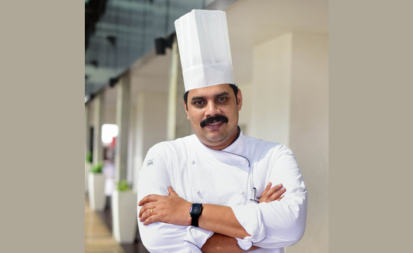How AI Powered Cooking is Transforming Meal Prep and Optimizing Nutrition
Authored article by Sanandan Sudhir Founder & CEO, On2Cook India Pvt. Ltd Artificial intelligence (AI), its advanced forms and other subsets/forms of technology has crept into various facets of our life. For instance, many now

Authored article by Sanandan Sudhir Founder & CEO, On2Cook India Pvt. Ltd
Artificial intelligence (AI), its advanced forms and other subsets/forms of technology has crept into various facets of our life. For instance, many now prefer a smartwatch with cutting-edge specs & features over sporting analog watches with old-school charm on their wrists, while celebs too are not shying away from launching their AI-based clones. It is thus high time these technological advancements were leveraged to bring about some more fundamental changes in our daily lifestyle, may be in the way we cook our daily meals. It isn’t that advanced devices or appliances have not been introduced in the past, but what lacked till now is a reformative technology that revamped the overall process and nitty-gritty of cooking. The future is AI combined with disruptive smart products, wherein big data & analysis-based optimized solutions are combined with products powered with combination technology – i.e. bringing the best of both worlds together to foster a sustained and healthy living.

The tradition is, however, being broken now with the advent of the combination cooking technology, which encapsulates the power of AI to revolutionize meal preparation as well as preservation of nutrients. Patented across US, UK and India, the combination cooking technology enables a combination of different traditional & modern cooking technologies, i.e. flame, induction and microwave, to cook anything in one-third the usual time. Besides, this transformative technology helps commercial as well as domestic kitchens save at least 40% on energy consumption while maximizing health and nutrition. To understand better the modus operandi of combination cooking tech, envision a semi-automated system that matches ingredients to recipes and an AI-system for error-free, SOP-based cooking.
One of the foremost benefits of this technology is that it eliminates the need of multiple cooking devices like fryers, grills, ovens, steamers, OTGs, air fryer, microwave etc. Additionally, it enhances the overall order processing efficiency in busy commercial kitchens. Such kitchens usually rely on printed kitchen order tickets (KOT), and verbal communication can lead to errors and delays. This disruptive technology integrates advanced technology to streamline order processing, minimize mistakes, reduce customer dissatisfaction as well as mitigate attrition rates.Also, traditional kitchen devices often require significant preheating times, ranging from 10 to 25 minutes. This leads to substantial energy wastage, as these devices are kept on for extended periods despite being actively used for less than 10% of the time. An AI-based combination cooking device minimizes wasted energy while optimizing preheating times. With this tech, there is no need to preheat other than oil for frying, which is nearly 6 minutes for 1.5 liters of oil for all traditional cooking methods like grilling, steaming, baking etc. Here, just take the food item straight from a cold pan, for despite being frozen, ready-to-eat can be expected in 3-5 minutes.
Since this technology comes equipped with an AI-powered app and IoT capabilities, it allows even a novice to cook like an expert chef.The AI-powered app basically helps automate recipes, adds water automatically, and simplifies cleaning. These features can boost profits by 15-20% each month, eventually letting the devices pay for themselves in less than 6 months. This technology plays an even more crucial role with respect to frying in commercial kitchens. For example a QSR outlet needs to serve food quickly and with consistency in taste. Currently, such kitchens normally fry food in bulk, say 12 patties at a time, and keep it warm before serving as per an order. It results in burgers, patties and chicken served at-least 15 to 30 minutes after cooking, compromising on the quality and making the food less fresh and crispy. In restaurants with a la carte orders and different cuisines, frying food takes time because they must preheat the oil and fry each batch. Combination cooking technology is the most apt solution in this regard as a device equipped with it can fry food quickly when an order is placed, so customers get freshly fried food like patties, burgers, or fries.
The usual frying time is 3.5 minutes for French fries and around 7 minutes for patties, but with combination cooking it gets drastically reduced to just 1 to 2 minutes. The combination cooking technology enables this as simultaneous cooking allows microwave to cook the food well from inside, allowing the kitchen to serve delicious burgers and fries as and when ordered.
And the best part is that this AI-based combination cooking technology cooks food that is healthier and more nutritious than food cooked using any other existing methodology. The novel technology ensures that vegetables and meats retain water-soluble nutrients, minerals, structure, texture and color, while preserving elements that are often lost in boiled or blanched food, and fried food picking up 40% less oil than usual. It effectively means that if someone on an average eats 2 punjabi samosas every day, they would consume nearly 10 liters of oil over the duration of a year.
So what exactly does this technology usher in with regard to transforming meal preparation and optimizing nutrition? It ushers in a kitchen where you can cook whatever and whenever you want, the healthiest and most nutritious food for your customers or loved ones, the most hassle-free cooking experience, and all that in the shortest possible time frame. Certainly, the time is not far before kitchens around the globe get revolutionized with this game-changing AI-based cooking technology.
——
 English
English French
French German
German Italian
Italian



